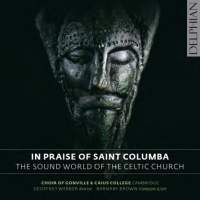Texte paru dans: / Appeared in: |
|
|
|
|
|
Reviewer: J.
F. Weber The Mass Propers are closer to the familiar chant than might be expected. Three are from Einsiedeln 121, with the gradual chant from the cantatorium St. Gall 359. The singing is unaccompanied, with a vocal drone in the alleluia and gradual chants. Both Swiss monasteries were founded by an Irish monk, and the interpretations agree with the common notion that virtuoso singers trained from childhood could execute the chant Propers with devotion and skill. The Office chants are closer to Tavener’s interpretation (one shared by Rebecca Tavener in her version of the Office of St. Brigit), involving the generous employment of instruments, not the only way divine worship might have been observed in medieval Celtic monasteries. The hymns are another story. Altus prosator is deserving of attention because it is an alphabetic hymn of 23 strophes (no j, u, or w, of course) with a refrain. It lasts over 25 minutes here, accompanied by lyre for the first 18 verses. Then, signaled by Tuba primi archangeli (the first archangel’s trumpet) at the 19th verse, two Medieval Irish horns join in and soon become so obtrusive that I thought I had acoustic feedback (though no microphone was connected). The intended effect is startling but disconcerting. In contrast, Adjutor laborantium is an alphabetic hymn of which we hear only six verses between A and X, sung as an unaccompanied solo joined in progress by an organal voice. A third hymn, Cantemus in omni die, not alphabetic, is sung metrically with 14 verses to instrumental accompaniment. In the end, this is a serious effort honestly presented for what it is. The notes, nine pages of fine print, are very frank about the limitations on speculative recreation of the music and the choices that are made here. The mode of performance, particularly with the use of instruments, is the result of “imaginative speculations.” The scholar Barnaby Brown and the director try to balance the observance of clerical rules with what was forbidden. It has long been assumed in a wider sphere that behavior repeatedly condemned must have continued to occur (in this case, the use of instruments). Else, why so many speed-limit signs on the highways if no one ever goes over 55? The hymn tunes are not presented as authentic at all, with two of them chosen from Bruno Stäblein’s collection and the third, Altus prosator, from a Welsh source that simply fits the text. The rhythmic performance of each of the three hymns is different simply for variety. Brown, an alumnus of the college, plays the triplepipe, a predecessor of the bagpipe, in the recording. I find room for disagreement on the use of instruments to accompany liturgical singing, but this is a fine effort to promote the discussion. Specialists will want to hear it. | |
|
|
|
|
|
|
|
Cliquez l'un ou l'autre
bouton pour découvrir bien d'autres critiques de CD |
|




